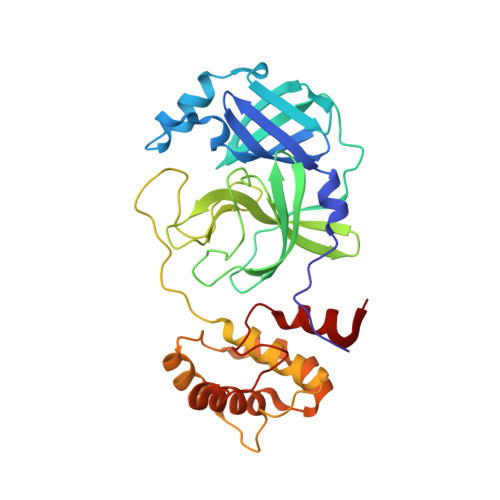Structure-based design of pan-coronavirus inhibitors targeting host cathepsin L and calpain-1.
Xie, X., Lan, Q., Zhao, J., Zhang, S., Liu, L., Zhang, Y., Xu, W., Shao, M., Peng, J., Xia, S., Zhu, Y., Zhang, K., Zhang, X., Zhang, R., Li, J., Dai, W., Ge, Z., Hu, S., Yu, C., Wang, J., Ma, D., Zheng, M., Yang, H., Xiao, G., Rao, Z., Lu, L., Zhang, L., Bai, F., Zhao, Y., Jiang, S., Liu, H.(2024) Signal Transduct Target Ther 9: 54-54
- PubMed: 38443334
- DOI: https://doi.org/10.1038/s41392-024-01758-8
- Primary Citation of Related Structures:
7W33, 7W34, 8GXG, 8GXH - PubMed Abstract:
Respiratory disease caused by coronavirus infection remains a global health crisis. Although several SARS-CoV-2-specific vaccines and direct-acting antivirals are available, their efficacy on emerging coronaviruses in the future, including SARS-CoV-2 variants, might be compromised. Host-targeting antivirals provide preventive and therapeutic strategies to overcome resistance and manage future outbreak of emerging coronaviruses. Cathepsin L (CTSL) and calpain-1 (CAPN1) are host cysteine proteases which play crucial roles in coronaviral entrance into cells and infection-related immune response. Here, two peptidomimetic α-ketoamide compounds, 14a and 14b, were identified as potent dual target inhibitors against CTSL and CAPN1. The X-ray crystal structures of human CTSL and CAPN1 in complex with 14a and 14b revealed the covalent binding of α-ketoamide groups of 14a and 14b to C25 of CTSL and C115 of CAPN1. Both showed potent and broad-spectrum anticoronaviral activities in vitro, and it is worth noting that they exhibited low nanomolar potency against SARS-CoV-2 and its variants of concern (VOCs) with EC 50 values ranging from 0.80 to 161.7 nM in various cells. Preliminary mechanistic exploration indicated that they exhibited anticoronaviral activity through blocking viral entrance. Moreover, 14a and 14b exhibited good oral pharmacokinetic properties in mice, rats and dogs, and favorable safety in mice. In addition, both 14a and 14b treatments demonstrated potent antiviral potency against SARS-CoV-2 XBB 1.16 variant infection in a K18-hACE2 transgenic mouse model. And 14b also showed effective antiviral activity against HCoV-OC43 infection in a mouse model with a final survival rate of 60%. Further evaluation showed that 14a and 14b exhibited excellent anti-inflammatory effects in Raw 264.7 mouse macrophages and in mice with acute pneumonia. Taken together, these results suggested that 14a and 14b are promising drug candidates, providing novel insight into developing pan-coronavirus inhibitors with antiviral and anti-inflammatory properties.
Organizational Affiliation:
Drug Discovery and Design Center, State Key Laboratory of Drug Research, CAS Key Laboratory of Receptor Research, Shanghai Institute of Materia Medica, Chinese Academy of Sciences, Shanghai, 201203, China.















